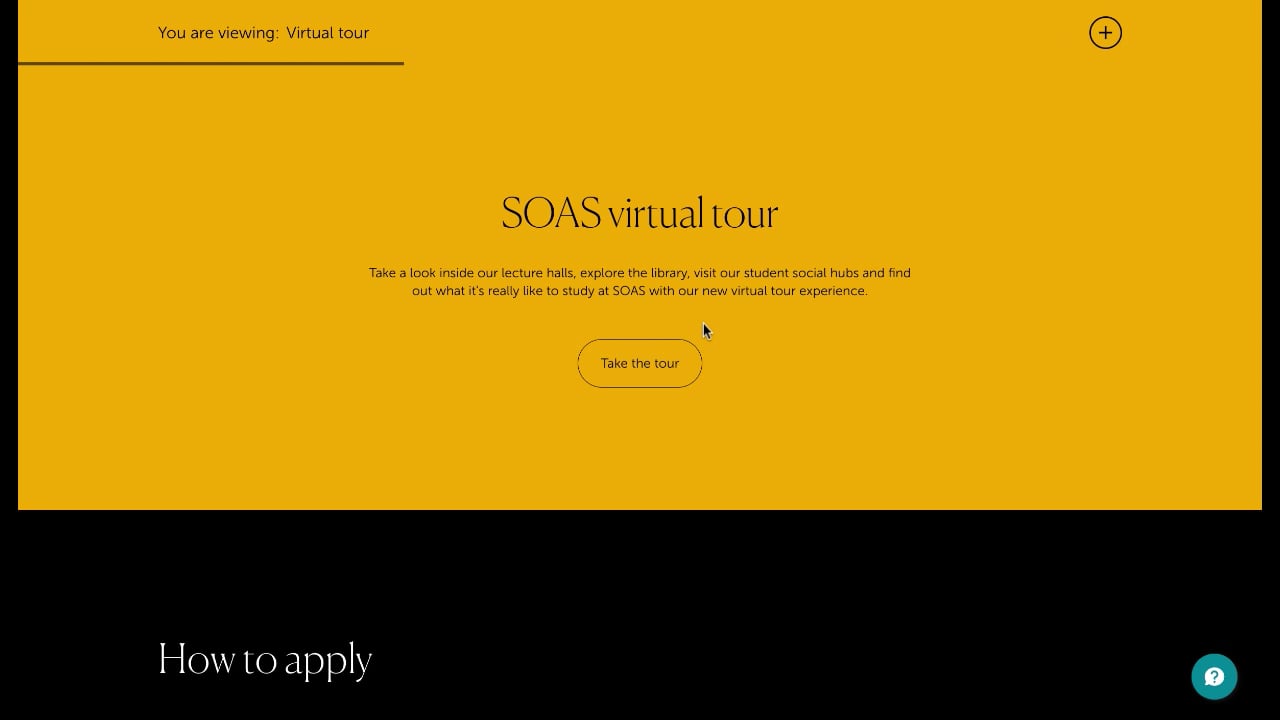International students have different needs and priorities than home students. In this article, we explore what they are looking for and how university websites can better serve them.
Recruiting international students is a top priority for universities across the UK. Last year, international student applications fell by 16%, driven by changes in Visa rules. This drop has heightened competition between universities to attract the brightest students from around the world.
Universities looking to boost international applications should focus their efforts on where they’ll have the biggest impact, and this is likely to be on their websites. The international student survey found that over 75% of international students said university websites were the most important source of information for them when deciding where to study. This is the world’s largest survey of prospective international students, receiving responses from well over 100,000 prospective students from 195 countries.
Many university websites could service international students much more effectively. User journeys for student recruitment are often structured around the needs and priorities of home students. International students are either completely disregarded or directed to a separate section of the website that can make them feel like an afterthought. In our experience, the most effective university websites weave key information and messages for international students into the fabric of their website, representing them across all relevant user journeys rather than confining them to a single section of the site.
International students have different priorities
Prospective international and home students have different needs and priorities when selecting a place to study. International students are making a conscious choice to move across the world, often to a country they are not familiar with. It’s only natural that this self-selecting cohort will ask different questions about the universities they are considering studying at.
Generally speaking, international students tend to be career-focused, concerned about the cost of their education, and highly focused on the ranking and reputation of the institution. They will also often know very little about the cities they are considering moving to, and may have concerns that differ from home students, such as safety.
Our recipe for crafting university websites that appeal to international students is simple — meet these needs and structure your content to reflect their priorities. This article will show you five ways your university website can do this.
Draw on your prestige
Highlighting your strengths in rankings and league tables is important when appealing to international students. You can also showcase the reputation of your academic staff by stressing their world-leading research or their track record of influential publications.
SOAS, University of London, provide a great example of how this can be achieved on course pages. Near the top of their course pages, they highlight their position in rankings for that subject via three concise bullet points.
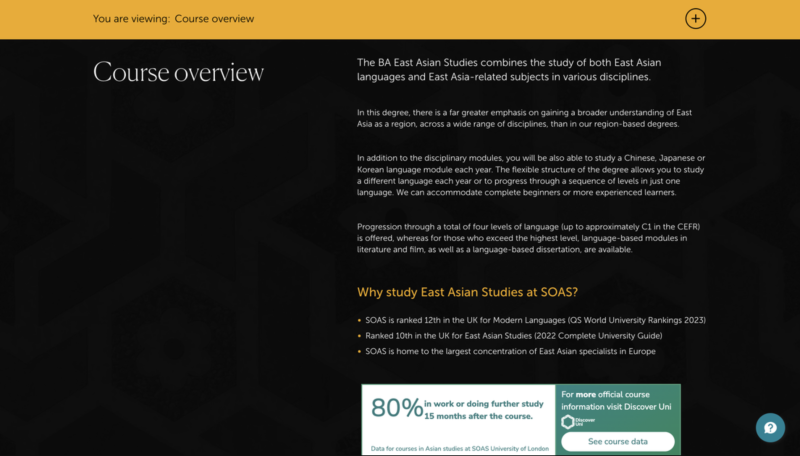
Showcasing the opportunities your degree unlocks through techniques like alumni stories can also enhance how your courses are perceived, given the focus international students have on employability.
Use tools to simplify entry requirements
University entry requirements are typically straightforward for home students, but international students must work out how their qualifications translate into the equivalent of UCAS points or a specific ‘grade’ offer. Given the huge variety of qualifications around the world, this quickly gets incredibly complex, and international students can be left wondering if they’d be accepted onto the course.
With students applying from such a vast range of countries, it’s impossible to list every single set of qualifications you’d accept, so we think the best solution is to give prospective students a conversion tool so they can easily see if they have the grades needed to apply. Leeds Beckett University provides a UCAS points calculator to let prospective students see how their unique set of qualifications converts into points.
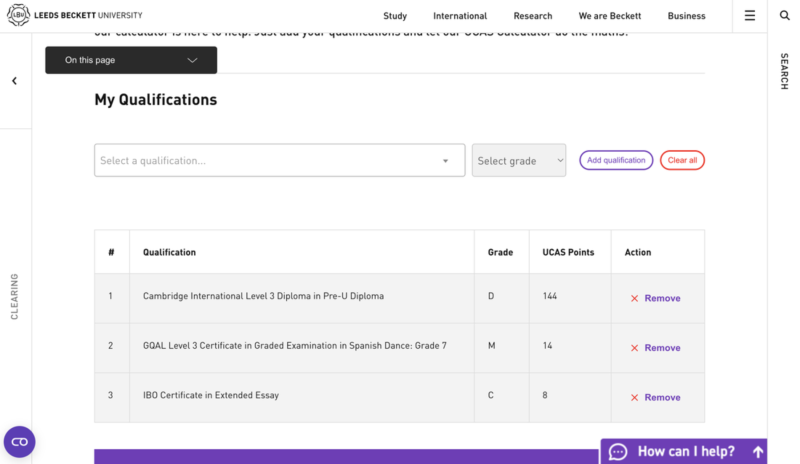
If your university uses grade offers (such as ABB) rather than UCAS points, you’ll still have some mechanism by which you establish if international students meet the required criteria. By operationalising this mechanism into a public-facing tool for prospective students, you can remove the need for administrative staff to answer queries from international students and provide a better user experience for those students.
Show the place & the people
91% of international students are ‘stealth applicants’ who don’t attend open days or make any form of direct contact with the university prior to submitting their application, because visiting in person is many times harder when you live thousands of miles away.
This means you need to show them physical amenities like campus facilities digitally, using tools like virtual tours.
SOAS, University of London, place their campus virtual tour front and centre on their hub page for international students.
This helps them convey the quality of their facilities and gives students a feel for where they can expect to be studying.
Open days aren’t just a chance to showcase your facilities. They also allow prospective students to interact with student ambassadors to ask questions and get a better sense of what it’s like to be a student at that university.
International students are often unable to attend in-person open days, but your website can step in to fill the gap by offering ways for prospective students to speak with existing students online. For example, the SOAS website uses Unibuddy to allow prospective students to talk to existing students and staff, helping to replicate an important part of the open day experience without the need to travel.

Student-generated content can also help convey the student experience without having to visit in person. For more information on utilising student-generated content, see our student-to-student marketing guide.
Don’t let them feel like an afterthought
It's common for university websites to have an 'international' section in their top-level navigation to provide a hub for content relating to international students.
While collating key information for international students in one place can be helpful, treating it as a separate section risks making international students feel marginalised. The most effective university websites weave international student content throughout their entire digital estate, especially on course pages where student excitement and engagement is highest. This means incorporating international entry requirements, student testimonials, and relevant content directly into course pages and other key sections of the website, rather than forcing students to navigate away to find this essential information.
SOAS, University of London, is a London-based university with an international outlook and large international student body. They reflect this international outlook with the design of their website, choosing photography from across the world to represent their courses rather than looking inward at their own campus. For example, the course page of the economics department at SOAS uses images of the global south to illustrate its courses, which have an internationally focused curriculum.
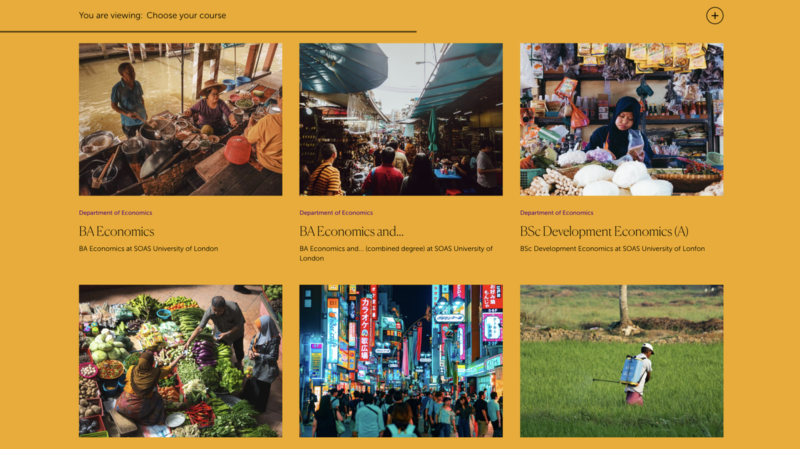
SOAS’s use of photography also authentically reflects its highly diverse student body, making prospective international students feel as though they’ll be a vital part of the institution, and not an afterthought.
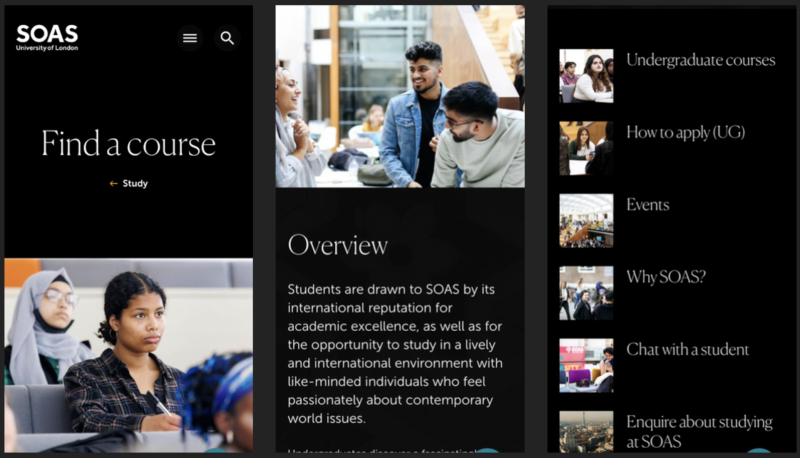
Spell out the benefits of your location
When prospective students are weighing up where to study, they are not just choosing a university. They are deciding where to live for 3 or more years. It’s a big choice for any student, but home students tend to have an existing level of knowledge about what different cities offer that international students may lack. For example, a prospective student from the UK might already know that Manchester is a great city for live music, is under an hour on the train from Leeds or Liverpool, and is around 2 hours by train from London. However, an international student may not have that context, so it’s worthwhile spelling out the advantages of your location, and thinking more broadly about the cultural amenities and major attractions that your location gives students access to.
A great example of how university websites can do this is Nottingham Trent University’s ‘Life in Nottingham’ page, which lays out all the city has to offer, from culture and sport to nightlife and shopping. It even has a food guide for international students, tailored to each region.
Does it work?
We’ve referred to SOAS, University of London, throughout this article as a great example of a university website that’s effective at attracting international students.
We worked with SOAS to redesign their website as part of a wider rebranding project that sought to define them as a leading international university for students looking to work on pressing global questions. Increasing the number of international students was an important part of the project, and the results show the effectiveness of the design choices at appealing to international students. After launching the new website, the number of users from outside the UK increased by 67%, and the number of students starting an online application increased by 219%. For more detail on the results SOAS were able to achieve, read our case study.
We’ve also had success increasing international applications for other universities, such as our project with Ravensbourne University which achieved a 104% increase in the number of international users.
If you’re considering improving your university website and making it more appealing to international students, we’d love to discuss how we can help. Get in touch, and we’ll set up an exploratory call with your team.
